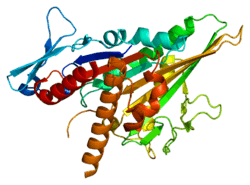KIFC3
Kinesin-like protein KIFC3 is a protein that in humans is encoded by the KIFC3 gene.[5][6]
References
- 1 2 3 GRCh38: Ensembl release 89: ENSG00000140859 - Ensembl, May 2017
- 1 2 3 GRCm38: Ensembl release 89: ENSMUSG00000031788 - Ensembl, May 2017
- ↑ "Human PubMed Reference:".
- ↑ "Mouse PubMed Reference:".
- ↑ Hoang EH, Whitehead JL, Dose AC, Burnside B (Dec 1998). "Cloning of a novel C-terminal kinesin (KIFC3) that maps to human chromosome 16q13-q21 and thus is a candidate gene for Bardet-Biedl syndrome". Genomics. 52 (2): 219–22. doi:10.1006/geno.1998.5431. PMID 9782090.
- ↑ "Entrez Gene: KIFC3 kinesin family member C3".
Further reading
- Diu A, Moebius U, Ferradini L, et al. (1993). "Limited T-cell receptor diversity in liver-infiltrating lymphocytes from patients with primary biliary cirrhosis". J. Autoimmun. 6 (5): 611–9. doi:10.1006/jaut.1993.1050. PMID 8240664.
- Hoang E, Bost-Usinger L, Burnside B (1999). "Characterization of a novel C-kinesin (KIFC3) abundantly expressed in vertebrate retina and RPE". Exp. Eye Res. 69 (1): 57–68. doi:10.1006/exer.1999.0671. PMID 10375449.
- Noda Y, Okada Y, Saito N, et al. (2001). "KIFC3, a microtubule minus end-directed motor for the apical transport of annexin XIIIb-associated Triton-insoluble membranes". J. Cell Biol. 155 (1): 77–88. doi:10.1083/jcb.200108042. PMC 2150803. PMID 11581287.
- Xu Y, Takeda S, Nakata T, et al. (2002). "Role of KIFC3 motor protein in Golgi positioning and integration". J. Cell Biol. 158 (2): 293–303. doi:10.1083/jcb.200202058. PMC 2173137. PMID 12135985.
- Strausberg RL, Feingold EA, Grouse LH, et al. (2003). "Generation and initial analysis of more than 15,000 full-length human and mouse cDNA sequences". Proc. Natl. Acad. Sci. U.S.A. 99 (26): 16899–903. doi:10.1073/pnas.242603899. PMC 139241. PMID 12477932.
- Ota T, Suzuki Y, Nishikawa T, et al. (2004). "Complete sequencing and characterization of 21,243 full-length human cDNAs". Nat. Genet. 36 (1): 40–5. doi:10.1038/ng1285. PMID 14702039.
- Gerhard DS, Wagner L, Feingold EA, et al. (2004). "The status, quality, and expansion of the NIH full-length cDNA project: the Mammalian Gene Collection (MGC)". Genome Res. 14 (10B): 2121–7. doi:10.1101/gr.2596504. PMC 528928. PMID 15489334.
- Roni V, Carpio R, Wissinger B (2007). "Mapping of transcription start sites of human retina expressed genes". BMC Genomics. 8: 42. doi:10.1186/1471-2164-8-42. PMC 1802077. PMID 17286855.
This article is issued from
Wikipedia.
The text is licensed under Creative Commons - Attribution - Sharealike.
Additional terms may apply for the media files.






